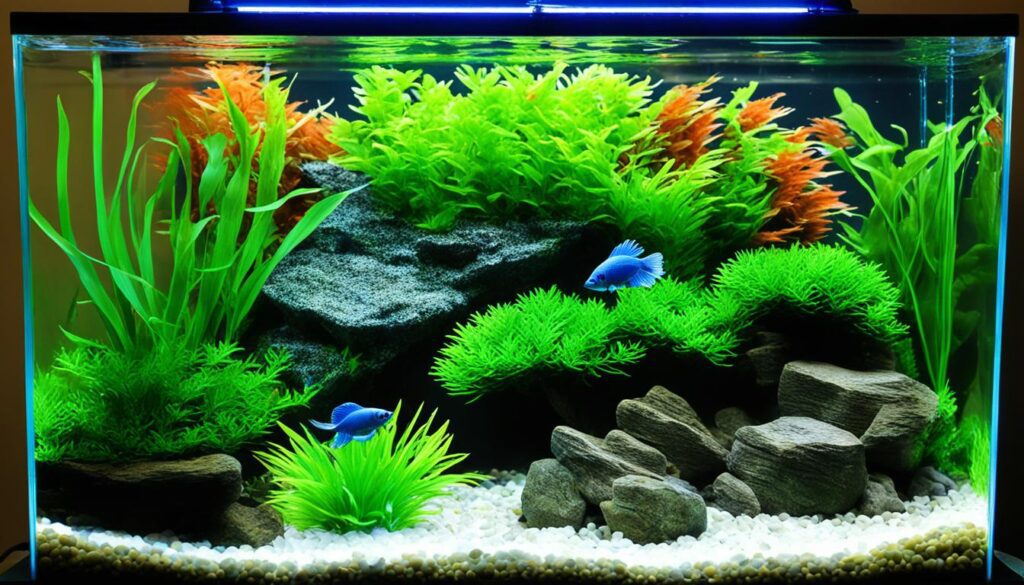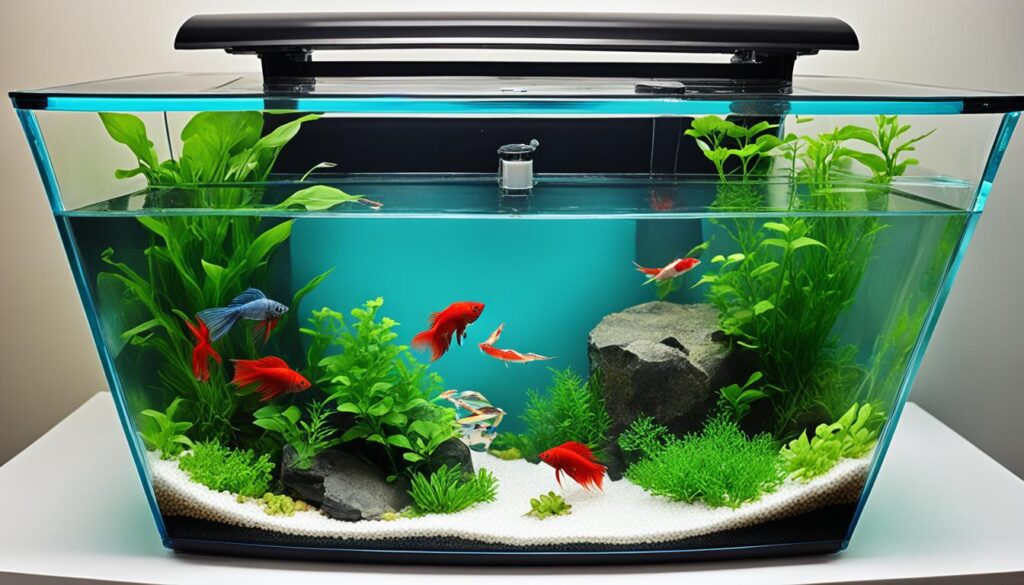As someone deeply into aquarium setup, I know that holding multiple betta fish is a big step. Seeing a betta swim freely shows its beauty. But, a tiny space can make it unhappy. Before planning your aquarium, here are some key tips.
Tank size is crucial. Betta fish need at least 2.5 gallons of water to swim freely and stay healthy. Small tanks, like vases, may look nice but need frequent water changes. This is both a hassle and an ethical issue when it comes to betta fish care.
Aggression is another concern. Typically, you should only have one male betta per tank to avoid fights. Even with dividers, problems can occur since diseases can spread in the shared water.
The idea of Betta Barracks might seem good, but it often leads to trouble. Bettas can try to escape. I suggest a 10-gallon tank for better water quality and easier care. Understanding these aspects is key for a peaceful betta fish home.
1. Understanding Betta Fish Social Dynamics

Betta fish are celebrated for their bright colors and elegant fins. They also show complex social behaviors. It’s key to know about Betta territorial behavior and Betta fish aggression for anyone keeping them. The interplay between male Betta territoriality and female Betta compatibility is crucial. It helps keep peace in an aquarium.
Recognizing the Territorial Nature of Bettas
Male Betta fish are very territorial. They fiercely protect their area from others. Putting many males together can cause non-stop Betta fish aggression. To avoid fights, keep them apart or give them lots of space and things to do.
Compatibility Between Male and Female Bettas
Male Bettas can be aggressive but can live with females in the right setup. The tank’s size and layout matter a lot. It helps females escape if males become aggressive. Watching how they act when first put together is important. This ensures their aggression stays low.
The Importance of Female Bettas’ Hierarchy
Female Bettas are less aggressive than males but still need a social order. A good group has at least three females. This sets up a natural Betta fish hierarchy. It lowers stress and limits fights, leading to a calm tank. Keeping a good group size is key for female Bettas’ happiness. See more on female Betta dynamics.
Behavior |
Impact |
Prevention Strategy |
|---|---|---|
Male aggression |
High risk of injury |
Separate tanks or ample space |
Female hierarchy formation |
Reduces stress |
Groups of three or more |
Mixed-gender interactions |
Potential stress |
Monitor and adjust as necessary |
Getting to know Betta fish social dynamics is a must. Understanding male Betta territoriality and female Betta compatibility is key. With this knowledge, aquarists can help these amazing fish live together peacefully.
2. Optimal Tank Conditions for Multiple Bettas

Keeping betta fish healthy requires focus on their living space. The size of the betta tank If you want to keep several Bettas together, especially females, the right environment is vital. It helps reduce stress and fights. Here’s how to make the ideal conditions for them to live peacefully.
- Tank Size and Betta Population: A big enough tank prevents overcrowding bettas. This means less fighting for territory. A spacious tank lets each Betta have its own area, which is good for their health and can help them live longer.
- Habitat Specifics for Females: For a group of female Bettas, get at least a 20-gallon tank. It should also have lots of plants. This makes them feel at home and comfortable.
- Considerations for Male Bettas: Since male Bettas tend to fight more, they need their own space. Keeping them in separate or divided tanks stops them from seeing each other. This helps prevent fights.
Good water quality is also crucial. The tank’s water needs to be kept clean and safe. Checking the levels of ammonia, nitrite, and nitrate regularly helps avoid illness and stress. This keeps the fish healthy and happy.
Betta Type |
Ideal Tank Size |
Lifespan Potential |
|---|---|---|
Single Male Betta |
5 gallons minimum |
7-8 years |
Betta Sorority (Females Only) |
20 gallons minimum |
7-8 years |
Multiple Males (Divided Tanks) |
20+ gallons (5 gallons per compartment) |
7-8 years |
Knowing that the betta fish environment impacts their well-being is key. A big enough tank and clean water are essential for betta care. Whether for a single male or a female group, providing space and clean water is essential. This ensures they live in harmony and stay healthy.
3. Strategies for Managing Aggression in Betta Fish

Betta fish stand out with their bright colors and unique personalities. Yet, they can often act aggressively. To keep these lovely fish in harmony, it’s key to understand and address their aggression. We’ll discuss ways to make their living space calm and friendly.
Using Dividers to Prevent Conflict
Using betta fish dividers is a top way to reduce fights. These barriers divide the aquarium, stopping physical fights before they start. Make sure dividers are high enough to stop fish from leaping over. They should also let water flow freely to keep conditions stable for all your fish. Here’s a look at different kinds of dividers:
Type |
Material |
Visibility |
Breathability |
|---|---|---|---|
Mesh Divider |
Soft Mesh |
Low |
High |
Acrylic Divider |
Clear Acrylic |
High |
Medium |
Planted Divider |
Live Plants |
Medium |
High |
Creating Line of Sight Barriers With Plants and Decorations
Adding aquarium plants for bettas and betta fish decorations helps lower stress. Items like Anubias or Java Fern and caves offer hiding spots. They give bettas their own space, reducing the need for battles.
Acclimating Bettas to Each Other’s Presence Safely
Don’t skip betta fish acclimation. Slowly introducing bettas to new tank friends cuts down stress and aggression. Use floating homes in the tank to let bettas see each other safely before they live together.
To manage betta fish aggression, balance is vital. Use barriers, place decorations smartly, and take time introducing fish to each other. These steps will lead to a peaceful tank, letting your bettas live well together.
4. Housing Multiple Betta Fish: Size Matters

When you want to keep more than one Betta fish, picking the right tank size is key. Many people start with small tanks, but then learn how important a big space is. I once put 3 male Bettas in a ten-gallon tank and learned a lot from it.
At first, I kept each Betta in a separate vase. It seemed fine initially. But soon, I saw how hard it was to maintain them that way. So, I moved them to a 10-gallon tank divided into three parts. Each part was 20 inches wide, 12 inches tall, and 10 inches deep. This was much better than the vases and met the standards for housing multiple Bettas.
The switch was about more than just adding water. I chose special materials to keep peace among the Bettas. I used perforated vinyl siding as dividers, which let water flow but kept the Bettas from seeing each other. This cut down on fights and kept the tank looking good.
Talking to others and my own experiences show planning for multiple Bettas needs thought about more than just size. You need to plant the tank well and pick calm Betta types, like Betta imbellis. Friends suggest using a 40-60 gallon tank for two Bettas. This helps manage their aggression and keeps them happy.
Creating a good home for Bettas is about care and commitment. Following good housing rules makes the Bettas’ lives better. It also turns an aquarium into a peaceful, eye-catching part of your home.
5. Water Quality and Filtration: Key to Betta Fish Health
Maintaining excellent water quality is essential for the health of betta fish. To ensure their well-being, it’s crucial to keep water conditions ideal. Betta fish thrive in water temperatures between 72–82°F and pH levels of 6.0–8.0.
I make it a point to monitor and adjust the tank’s environment to these standards. A stable habitat is key, especially when housing more than one betta. Their home must be just right.
Consistency in Water Parameters Is Crucial
Testing for pH, ammonia, nitrite, and nitrate levels lets me address any issues quickly. I aim to maintain a pH around 7 and nitrate levels under 40 ppm. This creates a safe environment for my bettas, away from chlorine and metal threats.
I always cycle a new tank to build a healthy ecosystem. This allows helpful bacteria to thrive and clean waste. It’s vital for keeping my bettas happy.
Filtration Systems: Balancing Flow Rate and Filtration
Choosing the right filtration system is about balance. It must clean the water well without creating strong currents. Bettas like calm water.
A 5-gallon tank filter with a 20 gallons per hour flow rate is ideal. Together with a suitable heater, it keeps the water at 75–80°F, perfect for bettas.
Frequency and Volume of Water Changes
The size of my tank influences how often I change the water. A 10-gallon tank needs a 30% change every two weeks. But a small 1-gallon tank requires changing more often, every few days.
This routine keeps my bettas healthy, allowing them to enjoy their food without pollution risks. Happy and vibrant bettas are the result of these practices.








